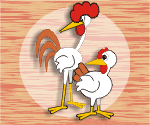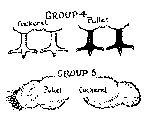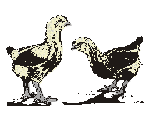
  


 
|
Sexing chicks
One
of the most difficult tasks for the backyard chicken breeder is that of sexing young
chicks.
Modern commercial hatcheries use a variety of tricks that allow them to determine the sex
of every chick from the moment it hatches. The most common way they do this, involves the
cross breeding of birds of particular colours which result in male chicks having different
colour down than female chicks. This is known as sex-linked crossing. I shall explain some
of the more common sex-linked crosses in this article as well as give some pointers on
sexing pure breed chicks.
Basically there are five different methods of determining sex in day old colour-crossed
chicks.
Group 1
This is the classic gold/silver cross. Mating a gold male such as Rhode Island Red, Buff
Rock, Buff Leghorn, Buff Orpington, Red or Buff Sussex to hens which are silver, such as
Light Sussex, Light Brahma or pure White Wyandotte, results in all the cockerel (male)
chicks having whitish grey or pale brown down, whereas the pullets (females) have
reddish-brown or buff down.
Group 2
Uses the hens mentioned above with black red type males like Old English or Modern Game,
Welsummer, Brown Leghorn, Dark Cornish or Barnevelders giving very similar results, except
the female chicks have brown stripes and markings. The male chicks have a lighter greyish
colour with black and grey markings.
Group 3
Involves non-barred males such as Australorp, Black Leghorn, Rhode Island Red or Ancona
mated with barred females such as Plymouth Rocks or Cuckoo Leghorns. The resulting chicks
are all black or dark brown with varying degrees of white underneath, however whereas the
females have dark brown or black heads, the males all carry a whitish spot on the back of
their heads.
Group 4
This relies on leg colour to determine the sex of the chicks, but as leg colour is not
always clearly defined in day old chicks, it is not as reliable as the above methods.
Mating dark legged males such as Silkies, Minorcas or Campines to females with light
shanks such as Sussex, Leghorns or Wyandottes gives male chicks with pale legs and female
chicks with dark legs.
Group 5
Uses feathering as a guide. Mating an early-feathering male such as an Ancona or Leghorn
to hens of a slow-feathering breed like Sussex or Rhode Island Reds will result in male
chicks which have very short flight feathers which do not protrude past the downy wing
coverts and females which show definite wing flights which show clearly past the wing
coverts. This method requires inspection immediately after hatching, before the males
feather growth "catches up" to that of some late hatching pullets. Of course, all these methods are completely useless
to the serious breeder of pure breeds of chickens. In these cases, it takes a little
longer to determine the males from the pullets, particularly with heavy breeds. It is
usually a simple matter to pick light breed males at about a month old. They sport much
larger and brighter head furnishings and are usually far more precocious than their
sisters. With heavy breeds it is sometimes easy to determine the pullets by their faster
and more even rate of feathering. Males feather more slowly and in a more patchy manner
(but this is not always the case with some strains).
The best method therefore, is by observing the chicks' behaviour. Startle
the chicks by sailing a hat or similar soft object over their heads and watch their
reactions. The cockerels will instinctively stand erect with their heads upright and will
emit a peculiar warning chirruping sound. The pullets will tend to crouch down low and
remain silent.
The following table shows the most common
differences in development between the sexes of heavy breed chicks at 5 week of age.
|





|
Cockerel |
5 Weeks of Age |
Pullet |
Medium size, pinkish |
Comb |
Small, yellowish |
Sturdy, long |
Legs |
Finer, shorter |
Stumpy, curved |
Tail |
Longer, straight |
Downy with thin line of stub feathers down centre
|
Back |
More advanced feathering along centre & flanks |
Feathering poorly advanced |
Side of neck, crop & flanks
|
Feathering well advanced |
Bare, showing wing covert quills |
Wing bows |
Covered with small feathers |
Erect and alert |
Carriage |
Lower set |
Copyright (c) 2001 .
All rights reserved.
Reproduction in whole or in part in any form or medium without express
written permission is strictly prohibited. |